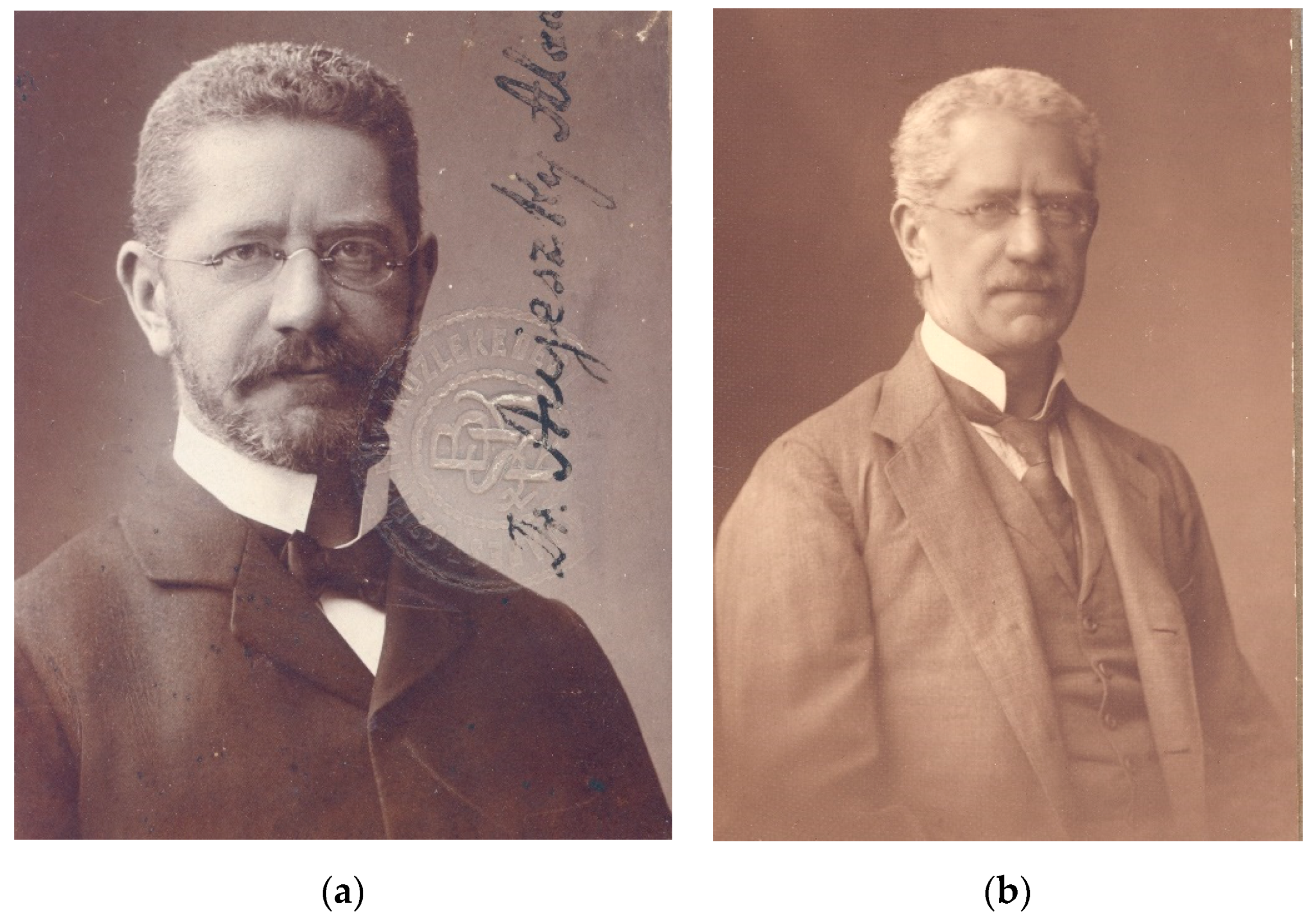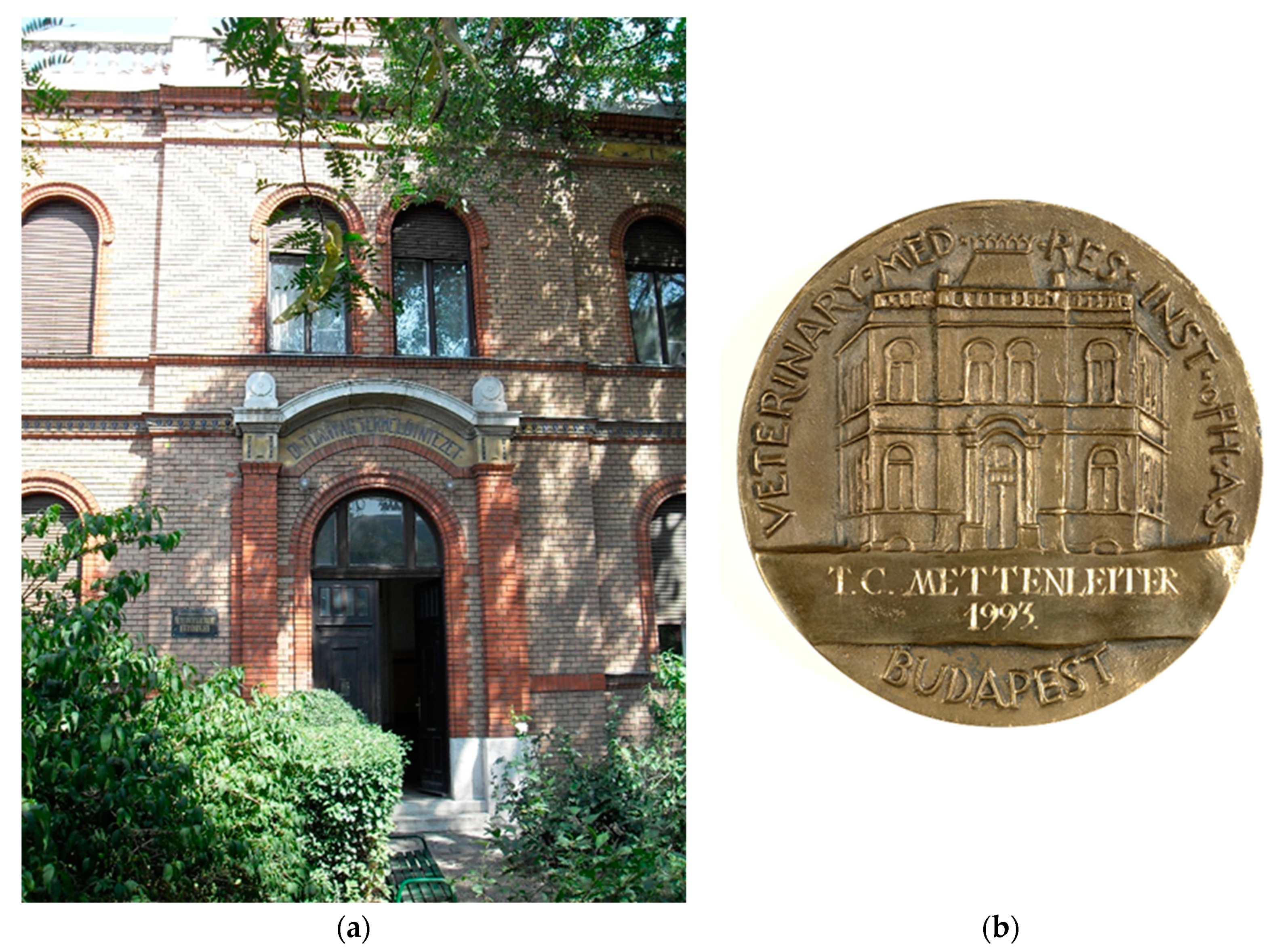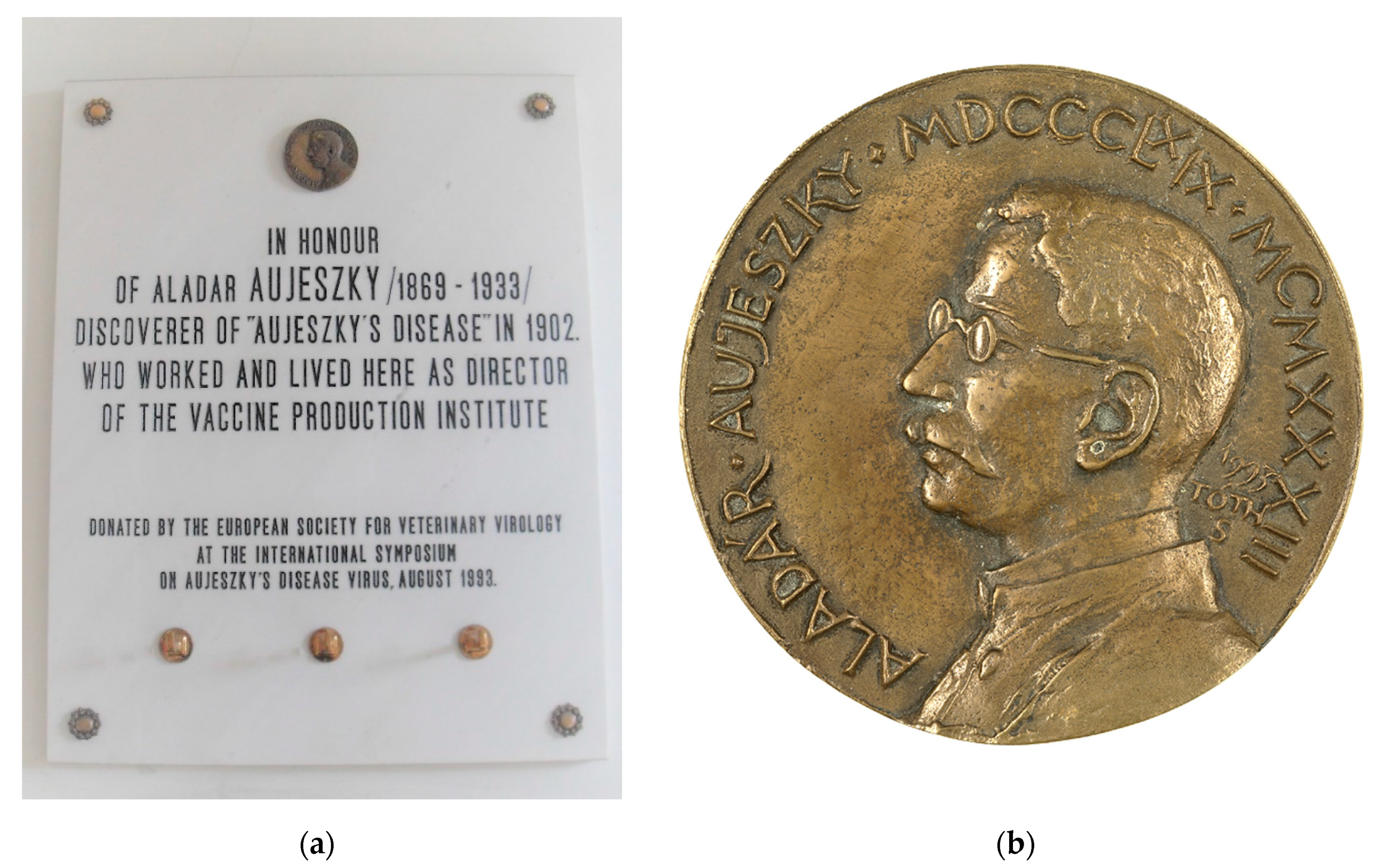Aujeszky’s Disease and the Development of the Marker/DIVA Vaccination Concept
Abstract
1. Early Reports on “Mad Itch”
2. Aladár Aujeszky and ‘Aujeszky’s Disease’
3. Pseudorabies (Aujeszky’s Disease) in Pigs
4. Novel Strategies for Animal Disease Control: Marker Vaccines and DIVA Tests
5. Conclusions
Funding
Acknowledgments
Conflicts of Interest
References
- Wyssmann, E. Nochmals zur Frage des Vorkommens der Aujeszky’schen Krankheit, Pseudowut, in der Schweiz. Schweiz. Arch. Tierheilkd. 1942, 84, 32–34. [Google Scholar]
- Hansen, R.P. The history of pseudorabies in the United States. J. Am. Vet. Med. Assoc. 1954, 124, 259–261. [Google Scholar]
- Köhler, M.; Köhler, W. Zentralblatt für Bakteriologie-100 years ago: Aladár Aujeszky detects a ‘new’ disease–or: It was the cow and not the sow. Int. J. Med. Microbiol. 2003, 292, 423–427. [Google Scholar] [CrossRef] [PubMed]
- Bartha, A. Aujeszky Memorial Lecture. Acta Vet. Hung. 1994, 42, 149–152. [Google Scholar] [PubMed]
- Aujeszky, A. Ueber eine neue Infektionskrankheit bei Haustieren. Cbl. Bakteriol Infektionskrankh. Parasitenkde. 1 Abt. Orig. 1902, 32, 353–357. [Google Scholar]
- Shope, R.E. An experimental study of ‘mad itch’ with especial reference to its relationship to pseudorabies. J. Exp. Med. 1931, 54, 233–248. [Google Scholar] [CrossRef] [PubMed]
- Elford, W.J.; Galloway, I.A. The Size of the Virus of Aujeszky’s Disease (“Pseudo-rabies”, “Infectious Bulbar Paralysis”, “Mad-itch”) by Ultrafiltration Analysis. J. Hyg. 1936, 36, 536–539. [Google Scholar] [CrossRef]
- Traub, E. Cultivation of pseudorabies virus. J. Exp. Med. 1933, 58, 663–681. [Google Scholar] [CrossRef]
- Sabin, A.B.; Wright, A.M. Acute ascending myelitis following a monkey bite, with the isoltion of a virus capable of reproducting the disease. J. Exp. Med. 1934, 59, 115–136. [Google Scholar] [CrossRef]
- Kaplan, A.S.; Vatter, A.E. A comparison of herpes simplex and pseudorabies viruses. Virology 1959, 7, 394–407. [Google Scholar] [CrossRef]
- Kretzschmar, C. Die Aujeszkysche Krankheit; Fischer Verl.: Jena, Germany, 1970. [Google Scholar]
- Heynen, K. Untersuchungen über den Nachweis und das Vorkommen der Pseudowut (Aujeszkyschen Krankheit) bei Schweinen in Deutschland. Z. Infekt.-Krankh. Parasitären Krankh. u. Hyg. d. Haustiere 1941, 57, 179–200. [Google Scholar]
- Mettenleiter, T.C.; Ehlers, B.; Müller, T.; Yoon, K.-J.; Teifke, J.P. Herpesviruses. In Diseases of Swine, 11th ed.; Zimmerman, J.J., Karriker, L.A., Ramirez, A., Schwartz, K.J., Stevenson, G.W., Zhang, J., Eds.; Wiley-Blackwell: Hoboken, NJ, USA, 2019; pp. 548–575. [Google Scholar]
- Pensaert, M.; Kluge, P. Pseudorabies virus (Aujeszky’s disease). In Virus Infections of Porcines; Pensaert, M., Ed.; Elsevier Science Publishers: New York, NY, USA, 1989; pp. 39–64. [Google Scholar]
- Sehl, J.; Teifke, J.P. Comparative pathology of pseudorabies in different naturally and experimentally infected species—A review. Pathogens 2020, in press. [Google Scholar]
- Ashworth, L.A.; Baskerville, A.; Lloyd, G. Aujeszky’s disease in the guinea pig: Cellular and humoral responses following immunization. Arch. Virol. 1980, 63, 227–237. [Google Scholar] [CrossRef] [PubMed]
- Watson, W.A. Epidemiology and control of Aujeszky’s disease in Great Britain. Rev. Sci. Tech. 1986, 5, 363–378. [Google Scholar] [CrossRef]
- Müller, T.; Bätza, H.J.; Schlüter, H.; Conraths, F.J.; Mettenleiter, T.C. Eradication of Aujeszky’s disease in Germany. J. Vet. Med. B Infect. Dis. Vet. Public Health 2003, 50, 207–213. [Google Scholar] [CrossRef]
- Freuling, C.M.; Muller, T.F.; Mettenleiter, T.C. Vaccines against pseudorabies virus (PrV). Vet. Microbiol. 2017, 206, 3–9. [Google Scholar] [CrossRef]
- Kit, S.; Kit, M.; Pirtle, E.C. Attenuated properties of thymidine kinase-negative deletion mutant of pseudorabies virus. Am. J. Vet. Res. 1985, 46, 1359–1367. [Google Scholar]
- Kit, S.; Sheppard, M.; Ichimura, H.; Kit, M. Second-generation pseudorabies virus vaccine with deletions in thymidine kinase and glycoprotein genes. Am. J. Vet. Res. 1987, 48, 780–793. [Google Scholar]
- Bartha, A. Attempts at reduction of virulence of Aujeszky virus. Mag. Allator. Lap. 1961, 16, 42–45. [Google Scholar]
- Bartha, A. Immunization experiments with the attenuated, K’strain of Aujeszky virus. Mag. Allator. Lap. 1962, 17, 321–323. [Google Scholar]
- Lomniczi, B.; Blankenship, M.L.; Ben-Porat, T. Deletions in the genomes of pseudorabies virus vaccine strains and existence of four isomers of the genomes. J. Virol. 1984, 49, 970–979. [Google Scholar] [CrossRef] [PubMed]
- Mettenleiter, T.C.; Lukacs, N.; Rziha, H.J. Mapping of the structural gene of pseudorabies virus glycoprotein A and identification of two non-glycosylated precursor polypeptides. J. Virol. 1985, 53, 52–57. [Google Scholar] [CrossRef] [PubMed]
- Mettenleiter, T.C.; Lukacs, N.; Rziha, H.J. Pseudorabies virus avirulent strains fail to express a major glycoprotein. J. Virol. 1985, 56, 307–311. [Google Scholar] [CrossRef] [PubMed]
- van Oirschot, J.T.; Rziha, H.J.; Moonen, P.J.; Pol, J.M.; van Zaane, D. Differentiation of serum antibodies from pigs vaccinated or infected with Aujeszky’s disease virus by a competitive enzyme immunoassay. J. Gen. Virol. 1986, 67, 1179–1182. [Google Scholar] [CrossRef] [PubMed]
- Quint, W.; Gielkens, A.; Vanoirschot, J.; Berns, A.; Cuypers, H.T. Construction and Characterization of Deletion Mutants of Pseudorabies Virus-a New Generation of Live Vaccines. J. Gen. Virol. 1987, 68, 523–534. [Google Scholar] [CrossRef]
- Mengeling, W.L.; Brockmeier, S.L.; Lager, K.M.; Vorwald, A.C. The role of biotechnologically engineered vaccines and diagnostics in pseudorabies (Aujeszky’s disease) eradication strategies. Vet. Microbiol. 1997, 55, 49–60. [Google Scholar] [CrossRef]
- Dong, B.; Zarlenga, D.S.; Ren, X. An overview of live attenuated recombinant pseudorabies viruses for use as novel vaccines. J. Immunol. Res. 2014, 2014, 824630. [Google Scholar] [CrossRef]
- van Oirschot, J.T. Diva vaccines that reduce virus transmission. J. Biotechnol. 1999, 73, 195–205. [Google Scholar] [CrossRef]
- van Zijl, M.; Wensvoort, G.; de Kluyver, E.; Hulst, M.; van der Gulden, H.; Gielkens, A.; Berns, A.; Moormann, R. Live attenuated pseudorabies virus expressing envelope glycoprotein E1 of hog cholera virus protects swine against both pseudorabies and hog cholera. J. Virol. 1991, 65, 2761–2765. [Google Scholar] [CrossRef]
- Klingbeil, K.; Lange, E.; Teifke, J.P.; Mettenleiter, T.C.; Fuchs, W. Immunization of pigs with an attenuated pseudorabies virus recombinant expressing the haemagglutinin of pandemic swine origin H1N1 influenza A virus. J. Exp. Med. 2014, 95, 948–959. [Google Scholar] [CrossRef]
- Pomeranz, L.E.; Reynolds, A.E.; Hengartner, C.J. Molecular biology of pseudorabies virus: Impact on neurovirology and veterinary medicine. Microbiol. Mol. Biol. Rev. 2005, 69, 462–500. [Google Scholar] [CrossRef] [PubMed]



© 2020 by the author. Licensee MDPI, Basel, Switzerland. This article is an open access article distributed under the terms and conditions of the Creative Commons Attribution (CC BY) license (http://creativecommons.org/licenses/by/4.0/).
Share and Cite
Mettenleiter, T.C. Aujeszky’s Disease and the Development of the Marker/DIVA Vaccination Concept. Pathogens 2020, 9, 563. https://doi.org/10.3390/pathogens9070563
Mettenleiter TC. Aujeszky’s Disease and the Development of the Marker/DIVA Vaccination Concept. Pathogens. 2020; 9(7):563. https://doi.org/10.3390/pathogens9070563
Chicago/Turabian StyleMettenleiter, Thomas C. 2020. "Aujeszky’s Disease and the Development of the Marker/DIVA Vaccination Concept" Pathogens 9, no. 7: 563. https://doi.org/10.3390/pathogens9070563
APA StyleMettenleiter, T. C. (2020). Aujeszky’s Disease and the Development of the Marker/DIVA Vaccination Concept. Pathogens, 9(7), 563. https://doi.org/10.3390/pathogens9070563




